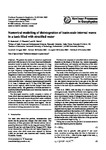Numerical modelling of disintegration of basin-scale internal waves in a tank filled with stratified water
| dc.contributor.author | Stashchuk, Nataliya | |
| dc.contributor.author | Vlasenko, Vasyl | |
| dc.contributor.author | Hutter, K | |
| dc.date.accessioned | 2015-11-29T10:23:02Z | |
| dc.date.available | 2015-11-29T10:23:02Z | |
| dc.date.issued | 2005-01-01 | |
| dc.identifier.issn | 1023-5809 | |
| dc.identifier.issn | 1607-7946 | |
| dc.identifier.uri | http://hdl.handle.net/10026.1/3860 | |
| dc.description.abstract |
<jats:p>Abstract. We present the results of numerical experiments performed with the use of a fully non-linear non-hydrostatic numerical model to study the baroclinic response of a long narrow tank filled with stratified water to an initially tilted interface. Upon release, the system starts to oscillate with an eigen frequency corresponding to basin-scale baroclinic gravitational seiches. Field observations suggest that the disintegration of basin-scale internal waves into packets of solitary waves, shear instabilities, billows and spots of mixed water are important mechanisms for the transfer of energy within stratified lakes. Laboratory experiments performed by D. A. Horn, J. Imberger and G. N. Ivey (JFM, 2001) reproduced several regimes, which include damped linear waves and solitary waves. The generation of billows and shear instabilities induced by the basin-scale wave was, however, not sufficiently studied. The developed numerical model computes a variety of flows, which were not observed with the experimental set-up. In particular, the model results showed that under conditions of low dissipation, the regimes of billows and supercritical flows may transform into a solitary wave regime. The obtained results can help in the interpretation of numerous observations of mixing processes in real lakes. </jats:p> | |
| dc.format.extent | 955-964 | |
| dc.language | en | |
| dc.language.iso | en | |
| dc.publisher | Copernicus GmbH | |
| dc.title | Numerical modelling of disintegration of basin-scale internal waves in a tank filled with stratified water | |
| dc.type | journal-article | |
| dc.type | Journal Article | |
| plymouth.author-url | https://www.webofscience.com/api/gateway?GWVersion=2&SrcApp=PARTNER_APP&SrcAuth=LinksAMR&KeyUT=WOS:000234749600015&DestLinkType=FullRecord&DestApp=ALL_WOS&UsrCustomerID=11bb513d99f797142bcfeffcc58ea008 | |
| plymouth.issue | 6 | |
| plymouth.volume | 12 | |
| plymouth.publication-status | Published online | |
| plymouth.journal | Nonlinear Processes in Geophysics | |
| dc.identifier.doi | 10.5194/npg-12-955-2005 | |
| plymouth.organisational-group | /Plymouth | |
| plymouth.organisational-group | /Plymouth/Faculty of Science and Engineering | |
| plymouth.organisational-group | /Plymouth/REF 2021 Researchers by UoA | |
| plymouth.organisational-group | /Plymouth/REF 2021 Researchers by UoA/UoA07 Earth Systems and Environmental Sciences | |
| plymouth.organisational-group | /Plymouth/Research Groups | |
| plymouth.organisational-group | /Plymouth/Research Groups/Marine Institute | |
| plymouth.organisational-group | /Plymouth/Users by role | |
| plymouth.organisational-group | /Plymouth/Users by role/Academics | |
| dc.identifier.eissn | 1607-7946 | |
| dc.rights.embargoperiod | No embargo | |
| rioxxterms.versionofrecord | 10.5194/npg-12-955-2005 | |
| rioxxterms.licenseref.uri | http://www.rioxx.net/licenses/all-rights-reserved | |
| rioxxterms.type | Journal Article/Review |


